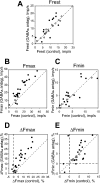Role of GABA A inhibition in modulation of pyramidal tract neuron activity during postural corrections
- PMID: 17425574
- PMCID: PMC2777253
- DOI: 10.1111/j.1460-9568.2007.05413.x
Role of GABA A inhibition in modulation of pyramidal tract neuron activity during postural corrections
Abstract
In a previous study we demonstrated that the activity of pyramidal tract neurons (PTNs) of the motor cortex is modulated in relation to postural corrections evoked by periodical tilts of the animal. The modulation included an increase in activity in one phase of the tilt cycle and a decrease in the other phase. It is known that the motor cortex contains a large population of inhibitory GABAergic neurons. How do these neurons participate in periodic modulation of PTNs? The goal of this study was to investigate the role of GABA(A) inhibitory neurons of the motor cortex in the modulation of postural-related PTN activity. Using extracellular electrodes with attached micropipettes, we recorded the activity of PTNs in cats maintaining balance on a tilting platform both before and after iontophoretic application of the GABA(A) receptor antagonists gabazine or bicuculline. The tilt-related activity of 93% of PTNs was affected by GABA(A) receptor antagonists. In 88% of cells, peak activity increased by 75 +/- 50% (mean +/- SD). In contrast, the trough activity changed by a much smaller value and almost as many neurons showed a decrease as showed an increase. In 73% of the neurons, the phase position of the peak activity did not change or changed by no more than 0.1 of a cycle. We conclude that the GABAergic system of the motor cortex reduces the posture-related responses of PTNs but has little role in determining their response timing.
Figures






Similar articles
-
Activity of pyramidal tract neurons in the cat during postural corrections.J Neurophysiol. 2005 Apr;93(4):1831-44. doi: 10.1152/jn.00577.2004. Epub 2004 Nov 3. J Neurophysiol. 2005. PMID: 15525811
-
Activity of pyramidal tract neurons in the cat during standing and walking on an inclined plane.J Physiol. 2009 Aug 1;587(Pt 15):3795-811. doi: 10.1113/jphysiol.2009.170183. Epub 2009 Jun 2. J Physiol. 2009. PMID: 19491244 Free PMC article.
-
Comparison of activity of individual pyramidal tract neurons during balancing, locomotion, and scratching.Behav Brain Res. 2006 Apr 25;169(1):98-110. doi: 10.1016/j.bbr.2005.12.009. Epub 2006 Jan 30. Behav Brain Res. 2006. PMID: 16445992
-
Dopaminergic inhibition of excitatory inputs onto pyramidal tract neurons in cat motor cortex.Neurosci Lett. 2001 Jul 20;307(3):175-8. doi: 10.1016/s0304-3940(01)01960-7. Neurosci Lett. 2001. PMID: 11438392
-
Long-range effects of GABAergic inhibition in gerbil primary auditory cortex.Eur J Neurosci. 2010 Jan;31(1):49-59. doi: 10.1111/j.1460-9568.2009.07039.x. Epub 2009 Dec 18. Eur J Neurosci. 2010. PMID: 20092555
Cited by
-
Contribution of supraspinal systems to generation of automatic postural responses.Front Integr Neurosci. 2014 Oct 1;8:76. doi: 10.3389/fnint.2014.00076. eCollection 2014. Front Integr Neurosci. 2014. PMID: 25324741 Free PMC article. Review.
-
Distinct Thalamo-Cortical Controls for Shoulder, Elbow, and Wrist during Locomotion.Front Comput Neurosci. 2013 May 21;7:62. doi: 10.3389/fncom.2013.00062. eCollection 2013. Front Comput Neurosci. 2013. PMID: 23734124 Free PMC article.
-
Contribution of the ventrolateral thalamus to the locomotion-related activity of motor cortex.J Neurophysiol. 2020 Nov 1;124(5):1480-1504. doi: 10.1152/jn.00253.2020. Epub 2020 Aug 12. J Neurophysiol. 2020. PMID: 32783584 Free PMC article.
-
Anticipatory postural adjustment: the role of motor cortex in the natural and learned bimanual unloading.Exp Brain Res. 2008 Mar;186(2):215-23. doi: 10.1007/s00221-007-1224-5. Epub 2007 Dec 4. Exp Brain Res. 2008. PMID: 18060544
-
Physiological and circuit mechanisms of postural control.Curr Opin Neurobiol. 2012 Aug;22(4):646-52. doi: 10.1016/j.conb.2012.03.002. Epub 2012 Mar 23. Curr Opin Neurobiol. 2012. PMID: 22446009 Free PMC article. Review.
References
-
- Alloway KD, Burton H. Differential effects of GABA and bicuculline on rapidly- and slowly-adapting neurons in primary somatosensory cortex of primates. Exp.Brain Res. 1991;85:598–610. - PubMed
-
- Alloway KD, Rosenthal P, Burton H. Quantitative measurements of receptive field changes during antagonism of GABAergic transmission in primary somatosensory cortex of cats. Exp.Brain Res. 1989;78:514–532. - PubMed
-
- Bard P, Macht MB. The behavior of chronically decerebrated cat. In: Wolstenholme GEW, O'Connor CM, editors. Neurological Basis of Behaviour. London: Churchill; 1958. pp. 55–71.
-
- Batshelet E. Circular Statistics in Biology. New York: Academic Press; 1981.
Publication types
MeSH terms
Substances
Grants and funding
LinkOut - more resources
Full Text Sources
Medical
Miscellaneous

